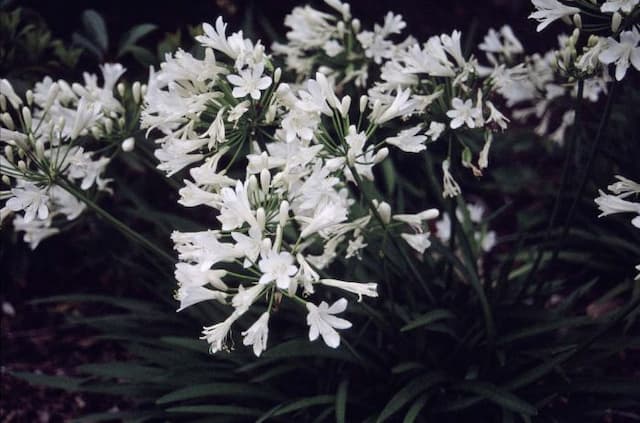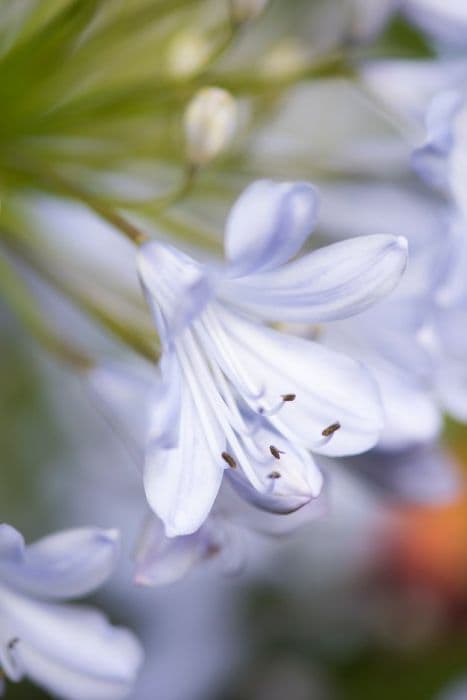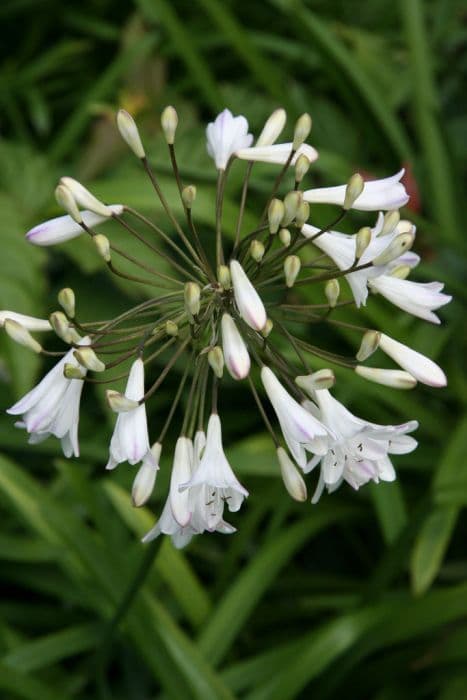Lily of the Nile Agapanthus 'Jacaranda'

ABOUT
The Agapanthus 'Jacaranda', commonly known as the Lily of the Nile, is a striking perennial that features lush clumps of strap-like leaves that are a deep green in color. The foliage presents itself in a graceful, arching form that provides a dense and textured backdrop for its most distinguishing feature: the blooms. The flowers of the Lily of the Nile 'Jacaranda' appear in large, rounded clusters, known as umbels, on top of tall, sturdy stalks that rise gracefully above the foliage. These impressive flower heads are comprised of numerous individual trumpet-shaped flowers. The 'Jacaranda' variety of Agapanthus is particularly noted for its deep blue to violet flowers, often with a hint of a darker stripe running down the middle of each petal. The contrast between the vibrant blues of the flowers and the green of the leaves makes the 'Jacaranda' a standout in any garden setting. The blossoms appear in abundance during the summer months, providing a vivid display of color. In general, the overall shape of the Agapanthus 'Jacaranda' is clump-forming, with its leaves and flower stalks emanating from a central base, creating a visual effect that is at once lush and elegant. The plant's structure and the arrangement of its blooms make it a popular choice for borders, as an accent plant, or when planted in mass for a dramatic effect in the landscape.
About this plant
 Names
NamesFamily
Amaryllidaceae
Synonyms
African Lily, Lily of the Nile, Love Flower
Common names
Agapanthus 'Jacaranda'.
 Toxicity
ToxicityTo humans
Lily of the Nile (Agapanthus) is known to be toxic if ingested. It contains several toxic compounds that can cause symptoms such as nausea, vomiting, abdominal pain, and diarrhea if parts of the plant are eaten. In severe cases, ingestion can lead to dizziness and tremors. Handling the plant may also cause skin irritation or allergic reactions in some individuals. It is advisable to avoid consuming any part of the Lily of the Nile and to exercise caution when handling the plant to prevent these potential consequences.
To pets
Lily of the Nile (Agapanthus) is also toxic to pets, including dogs and cats. If ingested, it can cause symptoms like vomiting, diarrhea, nausea, and abdominal pain. In some cases, ingestion can also result in more severe symptoms such as tremors or cardiac issues. Pet owners should prevent their animals from consuming any part of the Lily of the Nile and should seek veterinary attention promptly if they suspect their pet has ingested this plant.
 Characteristics
CharacteristicsLife cycle
Perennials
Foliage type
Evergreen
Color of leaves
Green
Flower color
Blue
Height
3 feet 4 inches (1 m)
Spread
2 feet (0.6 m)
Plant type
Bulb
Hardiness zones
8
Native area
South Africa
Benefits
 General Benefits
General Benefits- Ornamental Value: The Agapanthus 'Jacaranda', commonly known as Lily of the Nile, features striking blue or purple flowers that add aesthetic appeal to gardens and landscapes.
- Drought Tolerance: Lily of the Nile is known for its ability to endure periods of limited water, making it a sustainable choice for drought-prone areas.
- Low Maintenance: This plant typically requires minimal care once established, making it suitable for gardeners of all skill levels.
- Long Blooming Season: Lily of the Nile enjoys a prolonged blooming period during the summer, providing long-lasting color in the garden or as a cut flower in arrangements.
- Attracts Pollinators: The vibrant blooms are attractive to bees, butterflies, and other pollinators, supporting local ecosystems.
- Deer Resistance: The plant is generally resistant to deer, which can be beneficial in areas where deer predation is a problem for gardens.
- Erosion Control: Lily of the Nile has fleshy roots that help to stabilize soil, making it useful for controlling erosion on slopes and banks.
- Container Gardening: It is well-suited for container gardening, allowing those with limited space or unsuitable soil to still enjoy its beauty.
- Border Planting: The form and height of Lily of the Nile make it an excellent choice for borders and edges in garden design.
 Medical Properties
Medical PropertiesThis plant is not used for medical purposes.
 Air-purifying Qualities
Air-purifying QualitiesThis plant is not specifically known for air purifying qualities.
 Other Uses
Other Uses- The Agapanthus, often known as African Lily, can be used in the art of bonsai, where it is cultivated and trained to create a miniature, but realistic representation of a full-sized tree.
- The long and sturdy stalks of African Lily can be used in crafting, such as making natural wreaths or as a structural element in floral arrangements.
- In areas where African Lily grows abundantly, the fibrous leaves can be used in weaving to create mats, baskets, or other decorative items.
- African Lily can be planted as a living fence or border due to its clumping growth habit, offering a visual barrier in gardens and landscapes.
- The blooms of African Lily can be used as a natural dye, imparting hues onto fabrics or paper through soaking or boiling the petals.
- Dried African Lily flowers can serve as components in potpourri mixes, adding a touch of color and engaging textures.
- African Lily can be planted to stabilize soil and prevent erosion on slopes due to its robust root system.
- It can be used as an educational tool in schools for teaching plant biology and life cycles, due to its distinct flowering process.
- In colder climates, the African Lily can be grown in containers and brought indoors during winter months, teaching gardening adaptability and plant care.
- The seeds of African Lily can be used in crafts for children, such as making seed mosaics or for simple plant-growing projects.
Interesting Facts
 Feng Shui
Feng ShuiThe Lily of the Nile is not used in Feng Shui practice.
 Zodiac Sign Compitability
Zodiac Sign CompitabilityThe Lily of the Nile is not used in astrology practice.
 Plant Symbolism
Plant Symbolism- Love Letters: The scientific name Agapanthus is derived from the Greek words 'agape' (love) and 'anthos' (flower), which together mean 'flower of love'.
- Beauty: The striking blue to violet flowers of the African Lily symbolize beauty and fine appearance.
- Enduring Bonds: Its tough, fleshy roots that bind to the soil are often associated with endurance and long-lasting relationships.
- Home: Native to South Africa, the African Lily represents the concept of home or a place of belonging for South Africans dispersed around the globe.
- Peace and Tranquility: The cool blue hues of the flower evoke feelings of calmness and serenity.
 Water
WaterLily of the Nile requires consistent moisture, especially during the growing season. Water deeply once a week, providing about one gallon per plant to ensure the soil is moist but not waterlogged. During hot, dry spells, additional watering may be necessary. It's important to avoid overhead watering to prevent disease and instead focus on soaking the ground at the base of the plant. In winter, reduce watering significantly, but do not let the soil become completely dry.
 Light
LightLily of the Nile thrives best in full sun to partial shade. It requires at least six hours of sunlight daily for optimal growth and flowering. An ideal spot is one where it can receive morning sunlight and partial afternoon shade, especially in areas with very hot summers.
 Temperature
TemperatureLily of the Nile prefers temperate climates and does well in temperatures between 50°F and 80°F. It can withstand temperatures down to about 20°F, but frost may damage the foliage. It is not tolerant of extreme cold and should be protected or moved indoors if temperatures are expected to drop below this range.
 Pruning
PruningLily of the Nile should be pruned to remove spent flower stalks and to tidy up any dead or damaged foliage. Pruning can stimulate new growth and promote more vigorous flowering in the following season. The best time to prune is after flowering ends, typically in late summer or early fall.
 Cleaning
CleaningAs needed
 Soil
SoilLily of the Nile prefers well-draining soil with a pH of 6.0 to 8.0. A mix of two parts loam, one part perlite or sand, and one part organic compost or peat moss is ideal to ensure proper drainage and fertility for optimal growth.
 Repotting
RepottingLily of the Nile should be repotted every 2 to 3 years or when it becomes root-bound. Gently lift the plant and increase the pot size to give its roots more space to grow.
 Humidity & Misting
Humidity & MistingLily of the Nile is tolerant of a wide range of humidity levels but thrives best in moderate conditions. It does not require high humidity and can adapt to the air moisture levels commonly found in most homes.
 Suitable locations
Suitable locationsIndoor
Provide bright, indirect light and keep soil moist.
Outdoor
Choose sunny spot, well-draining soil, and water regularly.
Hardiness zone
8-11 USDA
 Life cycle
Life cycleThe Agapanthus 'Jacaranda', commonly known as Lily of the Nile, initiates its life cycle when its seeds germinate in moist, well-drained soil after experiencing a period of stratification to break dormancy. The seedlings emerge with grass-like foliage and slowly develop a root system. As the plants mature, they form evergreen clumps of strap-shaped leaves, with the growth period focused on vegetative development. In the blooming stage, typically in summer, tall stalks topped with clusters of blue to purplish trumpet-shaped flowers emerge, attracting pollinators. After flowering, seed pods may form, which eventually dry and release seeds for dispersal, or the plant can be propagated through division of its rhizomatous roots. As a perennial, the Agapanthus 'Jacaranda' will enter a period of dormancy in colder months, only to regrow from its roots when conditions are favorable in the following spring.
 Propogation
PropogationPropogation time
Spring-Early Summer
Propogation: The most popular method of propagating Agapanthus 'Jacaranda', commonly known as the Lily of the Nile, is by division. This is ideally done in the spring or early fall. To propagate by division, carefully dig around the plant to lift the fleshy, tuberous root mass from the ground. You will then gently separate the clumps into smaller sections, ensuring that each new section has at least one or two growing points or shoots. These divided sections can then be replanted in well-prepared soil, maintaining the same planting depth as the original plant. It's important to water the new plants thoroughly to help establish them. By using this method, the Lily of the Nile can be effectively propagated, preserving the characteristics of the 'Jacaranda' cultivar.



![African lily [Blue Storm]](/_next/image?url=https%3A%2F%2Fplants-admin.emdemapps.com%2Fimages%2Fplants%2F%2Fimages%2F604b63200a08b.png&w=640&q=75)





